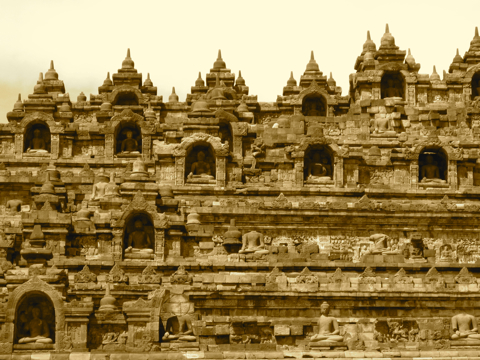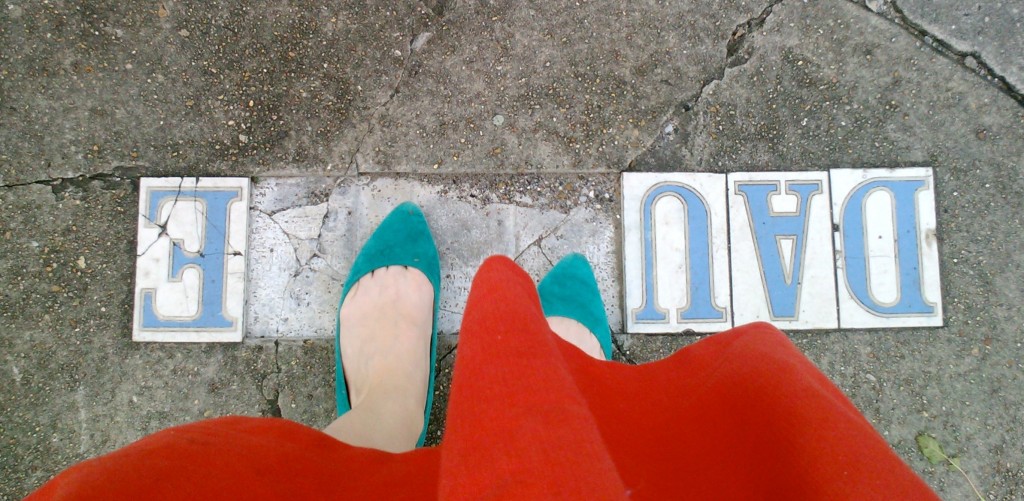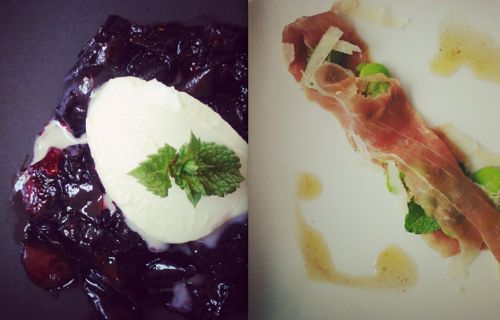
Borobudur monument in Java, Indonesia
In Bali, everybody looks good walking down the beach in their flowing sarongs. In Bali, the ocean crashes an appropriate distance away (not too close, and none too fiercely), and the sand looks like it’s made of the glimmering dust you find in Pixy Stix. Waiters—ubiquitous on Pixy Stix Beach—shake cocktails in coconuts, each of which is roped to the back of a friendly monkey who scampers up to you, smiling with his big monkey teeth.
This was my vision of Bali. I’m not gonna lie. And since I stayed at a snazzy hotel for part of my stay there, that vision was pretty well met, sans happy monkey. (Those dudes are fierce, and yes, they really do love bananas).
But what amazed me most about our recent trip to Singapore and Indonesia was how little I knew about the island just west of Bali—Java. Yogyakarta, its cultural capital, is an $80 hour-long flight from Bali’s main airport. And it is so, so worth it.
Our itinerary was New York to Shanghai to Singapore—a mall-driven, very clean city with excellent Indian food—followed by a short hop to Jakarta in western Java, and a quick drive to nearby Bogor. The Novotel Hotel was relaxing and gorgeous, with this sort of water world of a pool, a million little verdant paths, and great massages for ten bucks apiece. Our room came with a gratis and well-hidden gecko, who would croak “GECK-O” emphatically at 2 a.m. I tried to embrace the tropicality of it all, and things were looking good.
A couple of mornings later, though, the adventure portion of the trip began in earnest. Our driver drove up in a rickety blue minivan to pick up our group of five. The leader of our party had guesstimated an eight-hour trip ahead, from Bogor in west Java to Yogyakarta in central Java.
Wrong, our guide corrected him. That would be an 18 hour trip.
That’s a big difference when you’re in a bus with busted shocks and a crazy driver with an affinity for the gas pedal. It’s a big difference when you’re zipping along skinny winding mountain roads to stop at toilets set in the ground, with clouds of mosquitoes hovering overhead and zero squares of toilet paper in sight. (It would take me a week to stop carrying my own roll around when I got back to America). We stopped at mosques several times per day so our Muslim driver could pray—one hybrid mosque-gas station-rest-stop was pretty incredible—and I kept my nose in a 900-plus page Haruki Murakami novel to while away the hours. It wasn’t awful, and the scenery was beautiful, but it was exhausting, particularly for our two drivers.
When we arrived at our hotel at 11pm, having left at 6:45 that morning, I heard my beau say excitedly, “We’re falling asleep on the grounds of an ancient monument.” I mustered a grunt in reply, as I was busy gobbling up chicken satay, my first real meal of the day. I didn’t register our location.
We woke up the next morning, drank some bad instant coffee, stretched our arms and legs, and made our way down a path. We rounded a bend, and an incredible monument stretched into the sky.
Borobudur. It is breathtaking not in a mortal, normal way, but in the way that one imagines Lothlórien, the elven forest, might have been for Frodo and Sam. Buddha is everywhere at Borobudur. He is under the stupas (turrets), except the very top one, which at its zenith points straight like a lightning rod into the heavens. He is headless in some places—Muslim warriors reportedly chopped off his stone head long ago—and wears a beautifully serene expression in others. Hordes of tourists clamber everywhere, snapping photos, reaching to hold Buddha’s hand through holes in the stupa, which is thought to bring good luck. Most sport bright yellow sarongs, like happy fireflies. All seem to want to take their pictures with the very pale Americans.
Irrespective of religious tenets—I am not a practicing Buddhist—it would be hard not to be moved by this place. Carved into its sides are vignettes, many of people trying to distract Buddha from his journey towards enlightenment. Others are of animals, such as a bird with two heads. The top head, able to reach the best branches, eats fresh fruit. The bottom head has not such range, and is relegated to bruised fruit and dirt. The top head refuses to share, insisting that all the food benefits their mutual stomach. At last the second head, desperate with hunger, eats a poisonous mushroom. (It’s a tough moral story, but it’s one I’d love to somehow update for my nieces and nephew.)
Yogyakarta is a two-hour drive away—don’t trust Lonely Planet on drive times in Indonesia—and a neat little city, with the Sultan’s palace, the Kraton, at its center. The Hindu temple Prambanan is about an hour’s drive outside the city. There are colorful rickshaws and ex-pat bars, decent food and great people-watching.
So yes, the Singapore hawker markets were amazing, especially the woman at Tekka Market who spatulaed piping-hot dosas with one hand while dropping medhu vadai into boiling oil with the other. The air in Singapore Airport smells like ginger and sugar, and I ate the best soup dumplings of my life in that city. And Bali was wonderful and dreamy. Oodles of Elizabeth Gilbert wannabes writing in their journals and dreaming of love—not that I’m judging—couldn’t shake its charm. To that monkey in the Monkey Forest who detected a cherry cough drop wrapped in two layers of plastic and ate a corner of my bag: My hat is off to you, guy.
But for me, everything comes back to Borobudur, the sense of peace I felt there, and the goodwill towards others. I was in a quietly rapt state for the duration of my time there—perhaps my new ideal when it comes travel. Thank you to Java for that.











